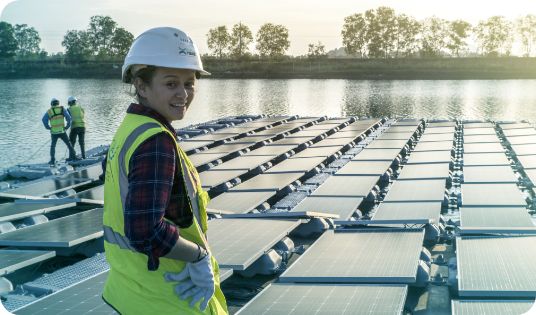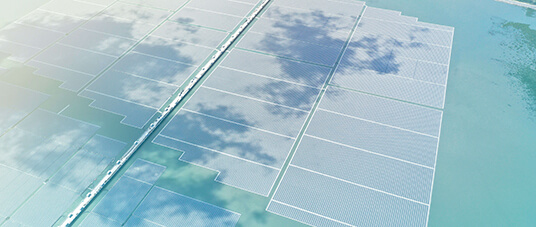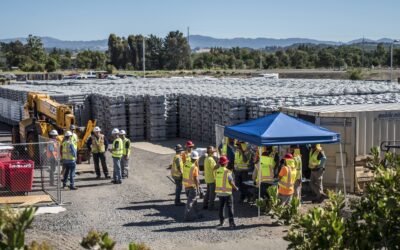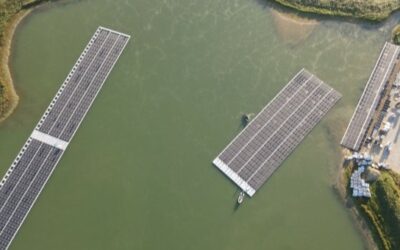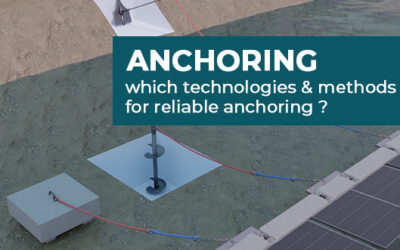With its 120 MWp, Omkareshwar is a large scale FPV project in India, designed, supplied and built by Ciel & Terre local teams, and with L&T working on the project as EPC. The plant was installed in a year on a very large dam reservoir thanks to RUMSLi, developing solar parks in the area under 2 phases under MNRE’s UMREPPii scheme. RUMSL has awarded Satluj Jal Vidyut Nigam (SJVN), a hydroelectric power and transmission company to develop the floating solar plant.
Omkareshwar: an extraordinary large scale FPV project in India
Omkareshwar 120 MWp floating solar project is located on a dam. Discover the challenges met and taken up, from the scale challenge in supply, logistics & construction preparation to the technical challenges in capacity optimization design and anchoring.
Logistics challenges on Omkareshwar large scale FPV project, India
When designing an energy project, we easily think to the environmental concerns (wind, soil for example). There can be societal concerns as well though. For Omkareshwar project, we also needed to respond to logistic challenges. Indeed, surrounding village roads are usually narrow, while road widening works were ongoing, usually stopping large vehicles locally. Additionally, roads were covered with water during rainy season; Narmada Bridge even weakening owing to floods.
To minimize those logistic issues, we set up a manufacturing factory less than 200 km away from the construction site.
An innovative use of rock bolt anchoring
Hydroelectric reservoirs are often built over a valley which has been flooded. Here in Omkareshwar, the dam’s depth can reach more than 28 meters, and the slope of the water body is more than 20% than usual. The soil of the dam also has an uneven bed, associated to water level variation. In order to not create tension disparity in the mooring lines, specific technics for reliable and cost-effective anchoring are needed. Concrete deadweights anchors are often not the right solution.

Additionally, its rocky nature makes hard the installation standard helical or plate anchors. Besides, wind is both high and unpredictable at Omkareshwar. The wind speed can reach up to 140 km/hour. This underlines the need for a specific anchoring system to achieve the right strength without any slippage of the anchors.
To respond to this unprecedented anchoring challenge, we innovated the use of underwater rock bolt anchoring. Rock bolt anchoring is a geotechnical engineering technology already used above ground for slope stabilization (hillsides, tunnels…). How does rock bolt anchoring work? After drilling, a several–meter steel rod is inserted in the hole and grouted under pressure with a cement mix. Once the grout has cured, the mooring lines are attached to the anchor heads poking out from the soil. To do that, we developed a specific underwater drilling structure, and a robust anchoring barge.
For the same resistance capacity, rock bolt is 200 times lighter than concrete deadweight anchor. Last but not least, rock bolt technique is 4 times less expensive. As far as CO2 emissions are concerned, one rock bolt anchor generates 25 times less CO2 than one concrete deadweight anchor in worst case scenario (non-recycled steel).
The anchoring installation lasted 9 months, including the connection of the mooring lines to the floating arrays and training for the unprecedented application of the rock bolt drilling technique.
Inverters barge: a necessary new solution for electrical equipment
Why did we develop a specific floating barge for electrical equipment? Because we wanted to enable the maximal energy yield for the project, counting 14 islands of 8.5 MW spread over 1 060 ACRE / 429 Ha. That way, we prevent from long distance cableways, consequently avoiding energy loss.
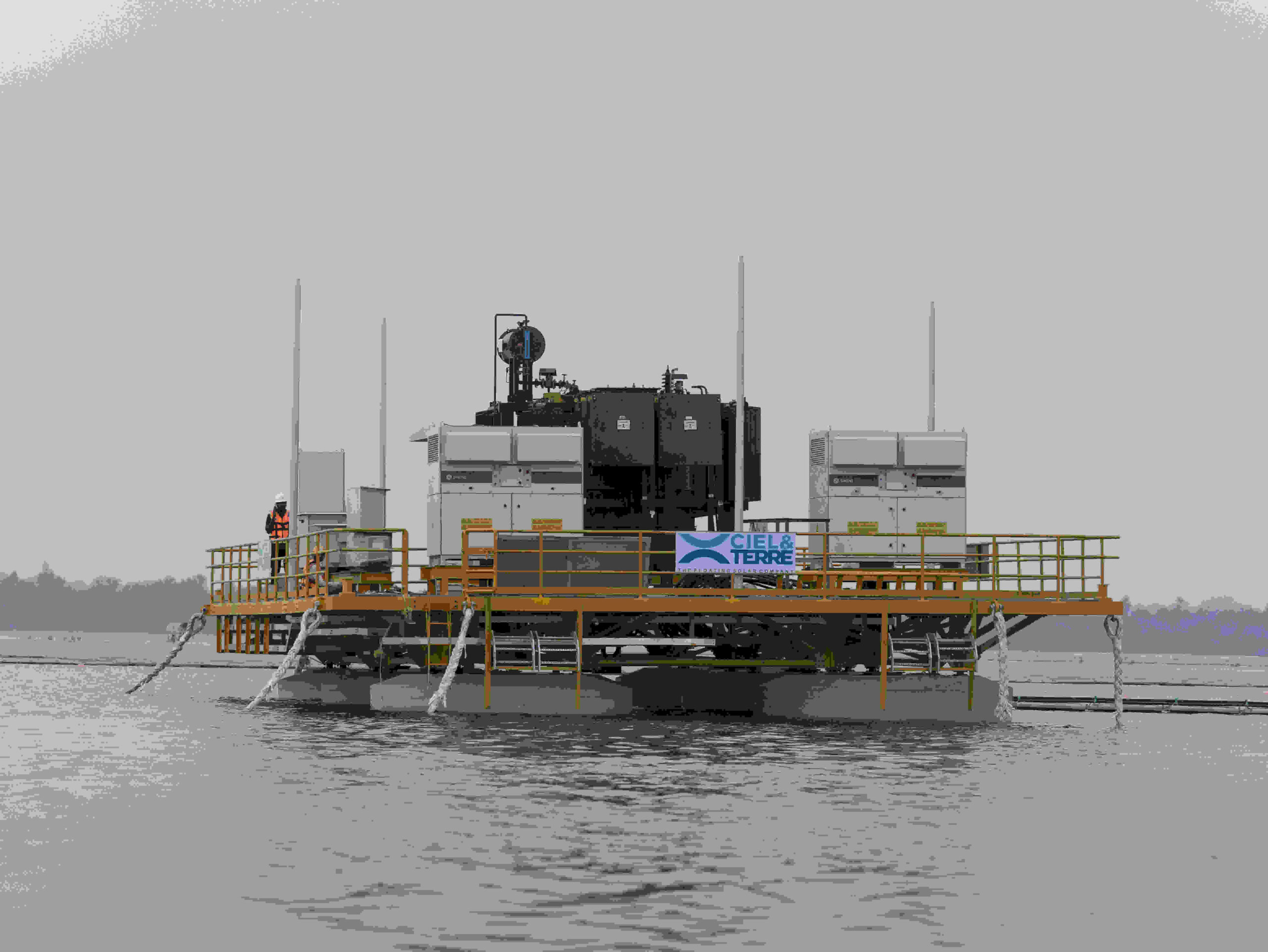
Electrical optimization with our patented inverter station barge
Fibre reinforced polymer barge
Usage under harsh condition
Design and product certified by naval classification society (RINA certified)
However, the usual main types of pre-existing barges couldn’t meet our specs1. So, we developed our own type of barge in order to house major electrical equipment (inverters, power transformers, auxiliary panel, LA, UPS, HT panel, witch gears). We engineered our floating barge to be modular and robust. We made sure that
- it is possible to carry out maintenance at any time and at ease
- it could support up to 50 tons~ of equipment.
Besides, our barge offers 50% higher strength-to-weight ratio than steel, and it is lighter product than its competitors.
Materials Details
- Marine grade FRP deck/pontoon: composite material = polymer matrix imbedded with high strength fibers like glass
- Steel structure: Hot rolled sections used for steel frames, coated with marine grade paint.
- Underdeck cable routing for trays fixation
- Handrails and bollards
- Gratings
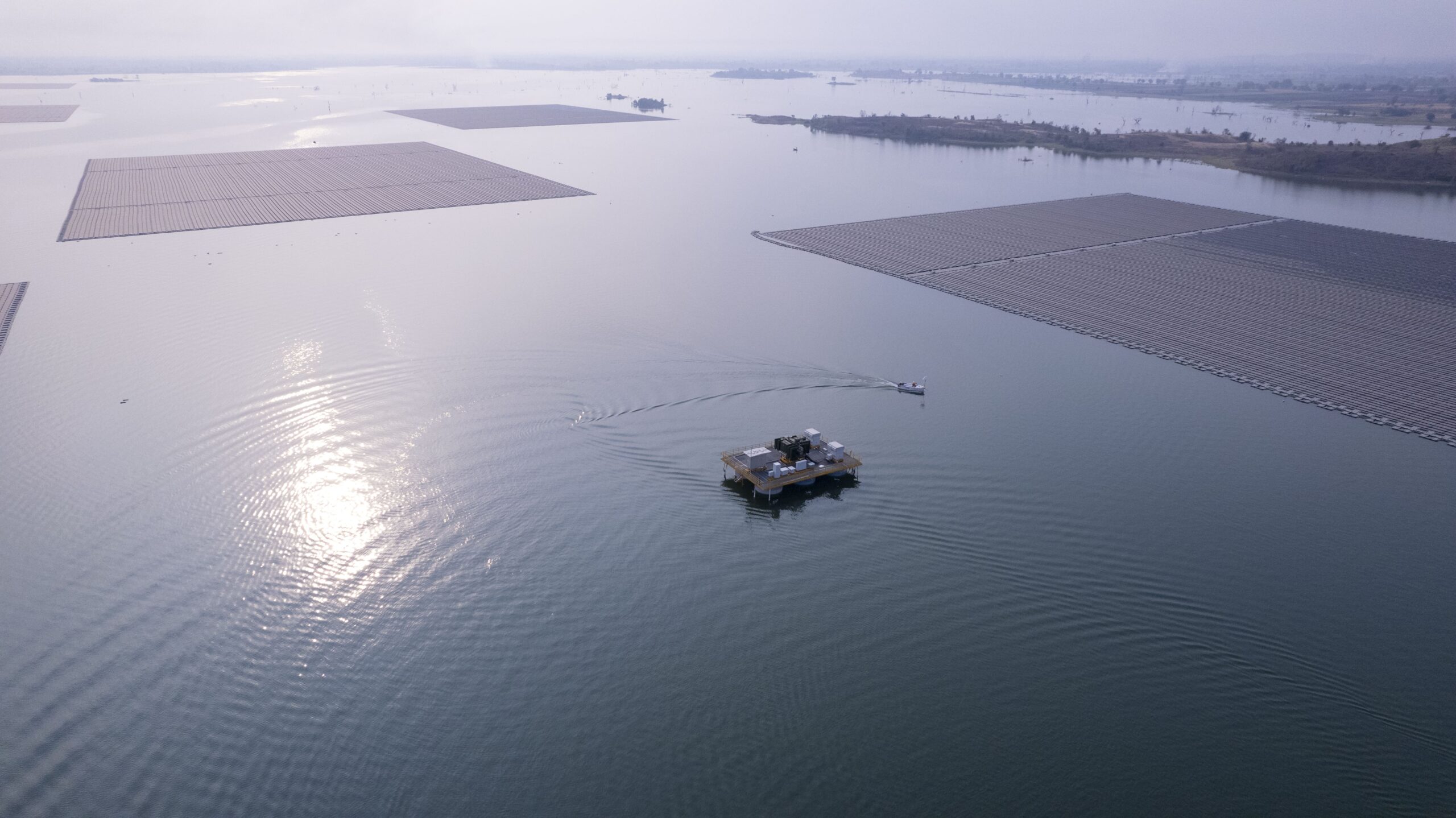
We can customize its design according to site conditions.
Learn more about Omkareshwar large-scale floating solar project in video:
How crucial is the site analysis? (and especially for a large-scale FPV project)
The site characteristics condition the way we design the floating solar plant, including the best way to run a smooth construction phase.
In the case of Omkareshwar, a number of site specificities led us to the 14 islands of 8.5 MWp we count today.
Understand site features to design relevant and reliable floating solar solutions
As mentioned earlier, the hard soil and strong unstable wind led us to install, and beforehand design, a brand-new anchoring technique: rock bolt anchoring.
High wind was actually one of the main challenges in Omkareshwar floating solar project. To face this challenge, we designed a specific configuration for Omkareshwar floating PV project: the 3-in-a-row. It enabled us to make a compromise between maximizing the yield while minimizing the load impacts on the floating structure. In that particular case, we expanded the capacity of each island by 4%. We also made adaptations to our PV module fixation system, and to our float connection pins because of high waves generated by high winds.
Besides, we can navigate the dam easily by sailing between the islands to not lengthen the trip time and distance.
Manage site specificities for a steady construction
Ciel & Terre teams also had to take into account a number of site specificities as well to manage the construction as smoothly as possible. First to prepare the construction, we took care of obstacles blocking parts of the reservoir: we removed tree trunks, handled protruded land contours, and had fishermen nets issues solved thanks to dredging.
During the construction, we had to plan rigorously our schedule. Indeed, the installation area we reached by boat was quite far from the banks. It required approximately 30 minutes by boat.
The depth of the reservoir as per its dam function was also a challenge as far as the anchoring installation is concerned, strengthening even more the challenge of applying a new technique for anchoring mentioned above.
Quality products: why is it important?
Making such a large-scale project successful would not have been possible if we hadn’t quality products. The environmental loads applied on Omkareshwar require a reliable solution which can handle them, from the anchoring solution to the floating platform, while respecting specs with high-capacity PV modules.
At Ciel & Terre in general, we have high quality standards which are above the market to ensure we can take up the challenges of FPV projects installed demanding environmental conditions.
Learn more about how we test our products:
To conclude and broaden the perspective
The completion large scale floating solar projects like Omkareshwar, 120 MWp, confirm the trends that the floating solar market is on the rise in India. In 2018, only 3 MW of floating solar had been installed in the country. In 2023, 434 MW cumulated were installed.
While India has experienced a rapid economic growth for the past 2 decades, the country’s electricity needs has also bloomed significantly. To pursue its goals of sustainable development, the country confirmed its commitment to achieving 500 gigawatts of renewable energy production capacity by 2030.
Learn more about the state of the FPV market in India:
By Laura, Marketing
